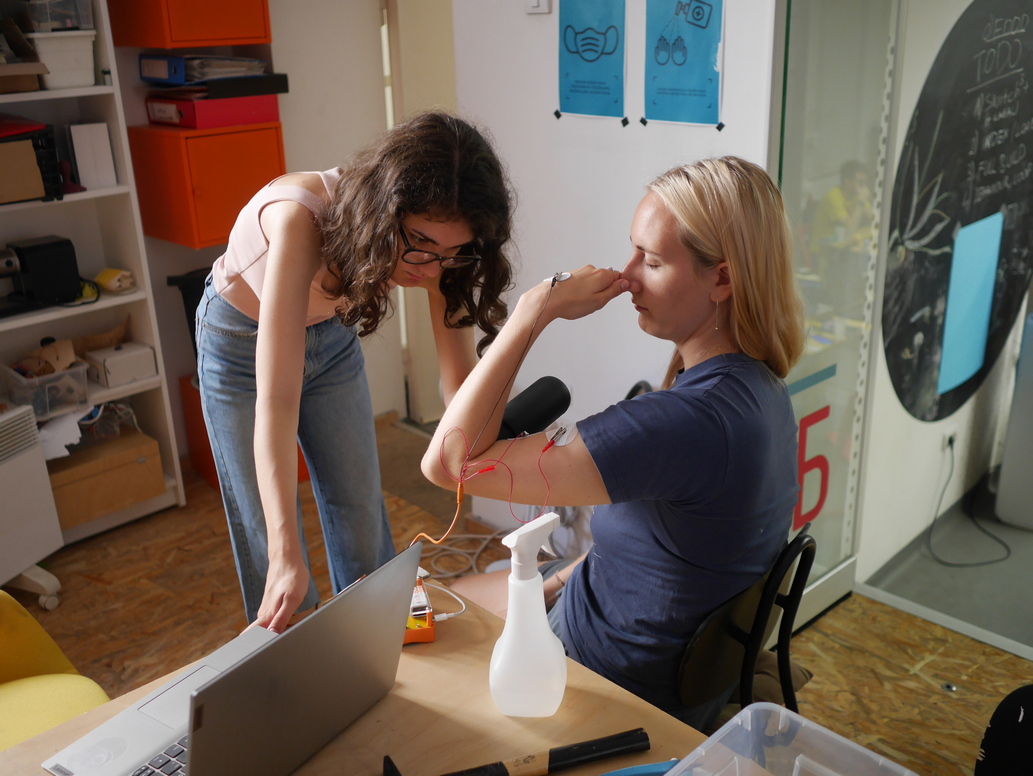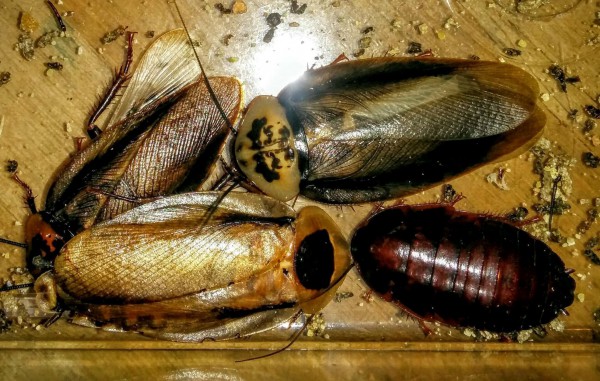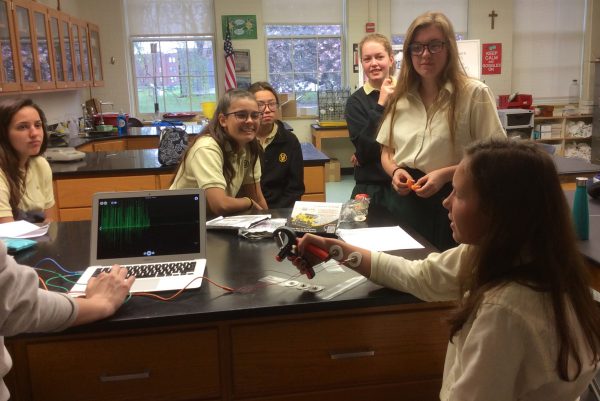-
 EducationWe are proud to have run many workshops in the Midwest, but co-founder Tim has longed to bring spikes to the Texas plains he recalls from his early years (he graduated from high school in El Paso and went to college in Austin). Thus, it was with great delight when Emily Verla Bovino, artist-in-residence with […]
EducationWe are proud to have run many workshops in the Midwest, but co-founder Tim has longed to bring spikes to the Texas plains he recalls from his early years (he graduated from high school in El Paso and went to college in Austin). Thus, it was with great delight when Emily Verla Bovino, artist-in-residence with […] -
EducationDESCRIPTION Update June, 2017: My paper was published! Check it out here in JUNE (Journal of Undergraduate Neuroscience Education). … Why are grasshoppers so hard to catch?! I aim to study the neuroscience behind this question by replicating past studies on grasshopper vision. Grasshoppers can sense an approaching object and quickly hop away to avoid collision with the object […]
-
 Experiment— Written by Milica Manojlovic — We are all familiar with the Pinocchio story, right? A wooden boy whose nose would grow every time he lied. What if I told you that, with the right equipment, you could feel like Pinocchio in a just few minutes? All you need is a massager (>50 Hz frequency and >1mm […]
Experiment— Written by Milica Manojlovic — We are all familiar with the Pinocchio story, right? A wooden boy whose nose would grow every time he lied. What if I told you that, with the right equipment, you could feel like Pinocchio in a just few minutes? All you need is a massager (>50 Hz frequency and >1mm […] -
 FellowshipHello again everyone! It’s Yifan here with the songbird project. Like my other colleagues I also attended the 4th of July parade in Ann Arbor, which was very fun. I made a very rugged cardinal helmet which looks like a rooster hat, but I guess rooster also counts as a kind of bird, so that […]
FellowshipHello again everyone! It’s Yifan here with the songbird project. Like my other colleagues I also attended the 4th of July parade in Ann Arbor, which was very fun. I made a very rugged cardinal helmet which looks like a rooster hat, but I guess rooster also counts as a kind of bird, so that […] -
 EducationWelcome to the cockroach world! My work for these five weeks was to develop a novel low-cost system to study the circadian rhythm of cockroaches. I’m working with my beautiful friends discoid cockroaches (B. discoidalis). Circadian rhythms are physical, mental, and behavioral changes that follow a roughly 24-hour cycle, responding primarily to light and darkness in an […]
EducationWelcome to the cockroach world! My work for these five weeks was to develop a novel low-cost system to study the circadian rhythm of cockroaches. I’m working with my beautiful friends discoid cockroaches (B. discoidalis). Circadian rhythms are physical, mental, and behavioral changes that follow a roughly 24-hour cycle, responding primarily to light and darkness in an […] -
 EducationDuring experiments on the giant axons of the Longfin Inshore Squid (loligo pealei) at the Marine Biological Laboratory in Woods Hole, MA; we were fascinated by the fast color-changing nature of the squid’s skin. Squids (like many other cephalopods) can quickly control pigmented cells called chromatophores to reflect light. The Longfin Inshore […]
EducationDuring experiments on the giant axons of the Longfin Inshore Squid (loligo pealei) at the Marine Biological Laboratory in Woods Hole, MA; we were fascinated by the fast color-changing nature of the squid’s skin. Squids (like many other cephalopods) can quickly control pigmented cells called chromatophores to reflect light. The Longfin Inshore […] -
 InternshipGreetings, this is Trevor coming live from Ann Arbor in a basement… We have one week left in the internship and things are finally starting to come together. Last time I made a post, I was without a doubt on the struggle bus in terms of getting data worthy of a poster, let alone a journal […]
InternshipGreetings, this is Trevor coming live from Ann Arbor in a basement… We have one week left in the internship and things are finally starting to come together. Last time I made a post, I was without a doubt on the struggle bus in terms of getting data worthy of a poster, let alone a journal […] -
 EducationGrant Funded Science! Just a hop and a skip away from our home office in Ann Arbor Michigan, Biology teachers at Okemos High School requested and received grant funding to introduce several Human-Human-Interfaces into their classrooms. The results left their students stunned… “‘This feels so weird!’ was a common exclamation. Most students laughed during the experience. A few disliked […]
EducationGrant Funded Science! Just a hop and a skip away from our home office in Ann Arbor Michigan, Biology teachers at Okemos High School requested and received grant funding to introduce several Human-Human-Interfaces into their classrooms. The results left their students stunned… “‘This feels so weird!’ was a common exclamation. Most students laughed during the experience. A few disliked […] -
 EducationBackyard Brains always loves hearing about our equipment making its way out into the world and into a classroom, so we were thrilled to hear from Dr. Nancy Cowdin, a Neuroscientist and Science teacher at Georgetown Visitation Preparatory School. Dr. Cowdin recently taught an elective course in Neuroscience where seniors at the all-girls high school […]
EducationBackyard Brains always loves hearing about our equipment making its way out into the world and into a classroom, so we were thrilled to hear from Dr. Nancy Cowdin, a Neuroscientist and Science teacher at Georgetown Visitation Preparatory School. Dr. Cowdin recently taught an elective course in Neuroscience where seniors at the all-girls high school […] -
 EducationWho says that hands-on approach doesn't work in virtual space? The DIY Neuroscience and AI for All workshop confirmed it!
EducationWho says that hands-on approach doesn't work in virtual space? The DIY Neuroscience and AI for All workshop confirmed it! -
 EducationHere at Backyard Brains, we often get the question “Is that leg really still alive?” to which we respond “Why yes… that’s why you hear the Spikes”. The follow up question “How does it stay alive?” was often replied with similar authority: “They have tiny holes called spiracles that allow them to ‘breathe’ through their […]
EducationHere at Backyard Brains, we often get the question “Is that leg really still alive?” to which we respond “Why yes… that’s why you hear the Spikes”. The follow up question “How does it stay alive?” was often replied with similar authority: “They have tiny holes called spiracles that allow them to ‘breathe’ through their […] -
![[Summer’16 Internship] Neuroscience of Grasshopper Jumps: Recording live neurons: the SpikeRecorder app](https://backyardbrains.com/experiments/img/TheActionPotential_Web.jpg) EducationIn the project instructions, I’ve briefly talked about the BYB SpikeRecorder app that I’ve been using on an iPad to add to my grasshopper vision project the flavor of a low-cost-and-DIY-albeit-of-great-quality tool. Here, I’ll talk about it in a bit more details to give the spotlight to one of the main components of my project. Firstly, […]
EducationIn the project instructions, I’ve briefly talked about the BYB SpikeRecorder app that I’ve been using on an iPad to add to my grasshopper vision project the flavor of a low-cost-and-DIY-albeit-of-great-quality tool. Here, I’ll talk about it in a bit more details to give the spotlight to one of the main components of my project. Firstly, […]
![[Summer’16 Internship] Neuroscience of Grasshopper Jumps](https://cdn.hackaday.io/images/1343911474750447009.JPG)